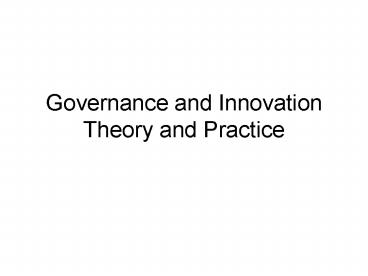Governance and Innovation Theory and Practice - PowerPoint PPT Presentation
1 / 17
Title:
Governance and Innovation Theory and Practice
Description:
Contest myopia, lock-in, path dependence etc. ... 6. A political consensus on at least the broad direction of development is desirable ... – PowerPoint PPT presentation
Number of Views:68
Avg rating:3.0/5.0
Title: Governance and Innovation Theory and Practice
1
Governance and Innovation Theory and Practice
2
Aim
- To explore challenges to governance associated
with focus on innovation - Assess conceptual differences with dominant (neo
classical) paradigm - Case study of Ireland for strategic governance
- Case study of wine industry for sectoral/regional
governance
3
Threshold Perspective
- 1983 on economic strategy based on deregulation
and privatisation - Focused economic governance primarily on
regulatory structure an inward turn to
governments own activity. - Political, institutional and administrative
patterns and political narratives have developed
to match these preoccupations - See Gary Banks and Ken Henry speeches for
eloquent defence of these approaches
4
Conceptual basis
- Grows from neo-classical economic paradigm a
powerful and robust body of analysis - Source of productivity gain in economy-wide
patterns of relationship. - Undistorted markets allocate factors of
production to their most efficient uses. - Market failure is a prime ground for remedial
action - Approach to innovation
- Science push view
- Focus on commercialisation
- Hi tech sectors
5
Innovation approaches
- Also focus on productivity gain and thus
complement conventional wisdom - But attained through enhanced value theory
demonstrates this is largely determined at
sectoral/regional level - Innovation analysis involves two basic steps
- At a strategic level, identify sectors that have
the weight and potential to matter to the whole
economy - At a sectoral level, identify impediments to
innovation that cannot be removed by firms acting
alone
6
Focus on sectors and impediments results from
differences in paradigms
- Is knowledge homogeneous or differentiated
category? is diffusion seamless or problematic? - Relative role of risk versus uncertainty
- Whole system versus market focus
- Method mechanics/equilibrium/modelling/ versus
judgment under uncertainty
7
Also, differences in approach to governance
- Model of rational actor fundamental to extension
of economic analysis to political relationships - In practice, these analyses recommend the
insulation of economic management - Public choice theory rent seeking is chronic.
- Partisan competition typically requires wasteful
political bribes. - Knowledge limitations limit capacity of state
- Picking winners is beyond state capacity
- By contrast, innovation and adjacent theories
offer qualified endorsement of public-private
engagement - Ensure opportunities for innovation are exploited
in sectors that matter - Interest engagement can be a win-win
- Constructive institutionalism - preferences
formed in inter-subjective contexts - Organisational learning, myopia, double loop
learning etc. - Vast literature on collaboration, linkage,
networks, knowledge management - Literature on state strategic capacity
- Literature on state strategy
- .
8
(No Transcript)
9
1. Innovation strategies distinct in scope and
analytic style
- See Forfas web site
- Picking winners in developing economies
- Identify sectors with weight and potential to
matter and map impediments to innovation - Uncertainties mean outcomes are provisional and
corrigible contexts and circumstances change - Can be more or less narrowly defined
- Technical analysis plus judgement like
determinations of monetary policy
10
2. The agency responsible for strategy needs to
be appropriately positioned
- Ireland, Denmark, Sweden, Finland, Singapore
versus UK. - Why partially separate strategy activity
- Middle manager resistance
- Paradigms, instruments, settings
- Qualifications
- Forfas established standing and legitimacy versus
Commission on Future but elite focus - Strategy Unit depended on Blair for political
impact time pressures - US Units attached to legislature - but distance
from executive
11
3. Interest engagement is a key element
- Public choice theory very pessimistic depends
on instrumental model of choice, - Other theories somewhat more sanguine
- logic of appropriate behaviour (March and
Olsen) - Constructive institutionalism key substantive
role of ideas they are weopens! - Partisan mutual adjustment (Lindblom)
- Contest myopia, lock-in, path dependence etc.
- Explore conditions for social learning in more
complex organisational, social and political
settings - Conceive broader political system as a knowledge
system writ large - But conventions of ministerial and cabinet
responsibility can hobble interest engagement.
12
More strategy issues
- 4. A partially separated focus on strategy
essential to realise synergies of joined up
government - 5. Strategy development is a continuous not
one-off exercise (Forfas 30 reports in 2008) - 6. A political consensus on at least the broad
direction of development is desirable - Demise of party id, party organisations
- Media as primary conduit but 24 hour news cycle,
spin, sound bites, populism - Media taste for sensationalism, short attention
spans etc.
13
Regional /sectoral strategies
- AWF Strategy Development
- Strategy 2025 1997
- Export development and R D strategies
- The Marketing Decade 1999
- Directions 2025 2002
- GWRDC 2002 2007 and 2007 2012
- Industry associations
- Industry media
14
Figure 2.3 The Impact of Collaboration on
Firm-Level Competitiveness
15
Lessons
- The industry bootstrapped its own success.
- Industry associations played critical brokerage,
leadership and coalition building roles. - 2. Success is a contingent and provisional
category. - 3. Government played critical catalytic and
facilitating roles. - 4. Can collaborative engagement be encouraged?
16
(No Transcript)
17
To sum up
- Beyond neo-liberalism (Kevin Rudd)? Is innovation
the next meta-strategy? - Innovation paradigm presents fresh challenge.
Differs from conventional wisdom in substantive
aspects and in implications for governance. - Innovation emphasises market system plus
knowledge system. Impacts role of government at
both strategic and regional/sectoral levels. - Recent theory and experience can guide analysis
and practice. - But specific approaches must be shaped to
specific contexts.































